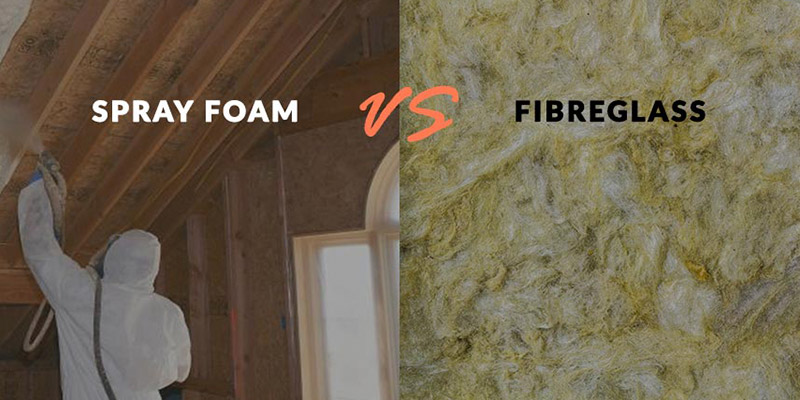
Fibreglass Insulation vs Spray Foam Insulation – Eco Spray Foam
When considering what type of insulation, you want, there are many factors to consider. Insulation types may depend on your budget, your property, area of insulation, location of property and many more factors. For this reason alone, we believe it is best to consult with a specialist to find out what is the optimum form of insulation for you. Here we are going to focus on a comparison between two forms of insulation, firstly, fibreglass insulation. This is one of the most common forms of insulation and has been widely used for decades. The insulation we will compare it with is spray foam insulation, this a relatively newer insulator, however, it is rapidly increasing in popularity. Let’s dive into the specifications between the two and find an insulation that is perfectly suited to you.
Fibreglass Insulation
Out of the two insulators up for comparison, fibreglass is the cheaper option. Therefore, if you’re on a tight budget, this may be the better option for you, however, at what cost? This form of insulation is very common and in some countries, as much as 85% of home insulation is based around fibreglass.
Fibreglass is composed of tiny glass fibres merged into thick sheets or rolls known as batts, and is easily placed into walls for insulation. Due to the ease of application, this insulator became very popular for home insulation. However, the R-Value of the material is a mere 2.2 and decreases over time, the R-Value is a measure of heat flow resistance through an insulator, such as fibreglass. Typically, this form of insulation has a lifespan of up to 25 years (if it remains dry) and it is a relatively cheap form of insulation. Additionally, fibreglass insulation has a low impact on soundproofing and doesn’t add any structural integrity to your property. What brought on the popularity of fibreglass is the sheer ease of installation, it doesn’t require a professional or a specialist and the batts can be cheap to purchase. Although, it is still highly advised to hire a professional for installation for optimum results. (If you do decide to install it yourself, please take the right measures to protect yourself when installing it. Fibreglass can cause irritation on your throat and skin)
We can sum up fibreglass insulation as the following: it is a popular form of insulation, commonly used for home insulations. It is a cheap insulator, composed of tiny glass fibres rolled into batts. It is one of the easier insulators to be installed a provides minimal heat protection with an R-Value of 2.2.
Spray Foam Insulation
Our next insulator in question is spray foam insulation, this insulator presents itself in two distinct forms, open-cell foam and closed-cell foam. These varying types of spray foam insulation holds their own benefits, depending on the property in need of insulation.
1) Open Cell Insulation:
Open-cell insulation is a more flexible and ‘airy’ form of insulation with an average R-Value of 3.5. This form of spray foam insulation is useful to find smaller nooks and crannies with its rapidly expandable composition. It is composed of polymer and it expands when sprayed. Open-cell foam acts as a superior air-barrier, absorbing air that tries to pass through it. If you require insulation for soundproofing, open-cell spray foam is highly recommended. Moreover, out of the two forms of spray foam insulation, open-cell is the cheaper option, however, with a less effective composition for retaining heat.
2) Closed Cell Insulation:
Closed-cell insulation, on the other hand, is one of the most superior forms of insulation for stopping heat transference, therefore, keeping your property warmer. This insulator has a significant R-Value of up to 7 and both closed-cell and open-cell can last up to and over 80 years. Closed-cell foam insulation is composed of thicker and more dense cells which retains heat and it is resistant to water vapour and moisture and mould growth. Moreover, closed-cell foam insulation adds structural integrity to a building, therefore, it is perfect for those areas subject to harsh winds and even earthquakes.
Insulation Comparison Conclusion
Although spray foam insulation has a higher cost, it is by far the superior insulator. Moreover, in the long-term, due to reduced usage in heating and cooling of your property, you actually save money on energy bills and see a return on investment, highlighting the benefits of using spray foam insulation. Fibreglass’s only benefit is that it can be installed by yourself, with caution, yet in regards to insulating to retain heat, protect against mould, water permeable, soundproofing, structural integrity and more, foam insulation wins by a landslide. If you’re still unsure, would like to find out more or would like to have a free survey/consultation from one of our specialists, contact us at info@sprayfoam.co.uk. We have over 21 years’ experience and a team of experts in the insulating field.


